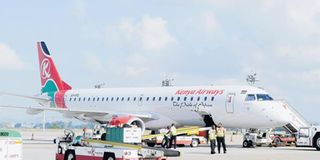Balance of airline’s assets and liabilities raises more queries

A Kenya Airways jet. FILE PHOTO | KEVIN ODIT |
What you need to know:
So I ask again, why is the public being allowed to continue buying Kenya Airways share at the NSE? Shouldn’t it be suspended from the exchange?
When running a business, it is very important that you balance your borrowings. Ideally, long-term debt should be used in acquiring long-term assets and short-term debt for short-term assets.
Think about it: does it sound sensible to take a one-year loan for the purchase of an item that you only intend to keep for six months? Why would you want to be left paying a loan for something that you no longer own?
Conversely, it is also not good to buy an item that you intend to keep for five years with a loan repayable in six months. It might look like a smart move at first, but remember that the shorter the term of a loan, the higher its instalments are.
If you took out a one million-shilling loan to buy a car — which you’ll probably keep for five years before selling — at, say 18 per cent interest but planned to pay it back in 36 months (three years), your monthly instalments would be about Sh36,000.
However, if you wanted to clear this loan in, say, six months, you would have to cough up Sh175,500 each month.
Two questions arise immediately: first, can you afford this kind of money? Second, if yes, why are you taking the loan? Why not simply save the money and buy the car without borrowing?
With that knowledge in mind, it is clear that a good business would ensure that its short-term assets are at least equal to its short-term liabilities. The difference between these two values is what accountants call Working Capital.
I suspect that the name “Working Capital” arises from the expectation that a normal general trader would be buying goods for sale with short-term loans. After selling the goods, he would make a profit enough to pay the loan instalment and leave a profit.
What about Kenya Airways? Last week we saw that the company’s assets do not cover its liabilities. Now we can ask whether the company has enough Working Capital. The published audited accounts show that it has short-term assets worth Sh41 billion and short-term liabilities valued at Sh82 billion.
Let’s put that into perspective. Imagine you own a shop which has stock valued at Sh410,000 and you know you need about a year to sell all off. But you also owe suppliers, the land-lord, banks and others Sh820,000 which is payable during the same period.
In such a situation, there is a good chance that each time you sell, you will use that money to pay off some debt. You will hardly ever have any money to do anything else — not even to buy your own lunch!
That is exactly where Kenya Airways is. The Nairobi Securities Exchange (NSE) listing rules state that companies must have “adequate working capital”. Kenya Airways has none: Sh41 billion minus Sh82 billion is negative Sh41 billion.
So I ask again, why is the public being allowed to continue buying Kenya Airways share at the NSE? Shouldn’t it be suspended from the exchange?




